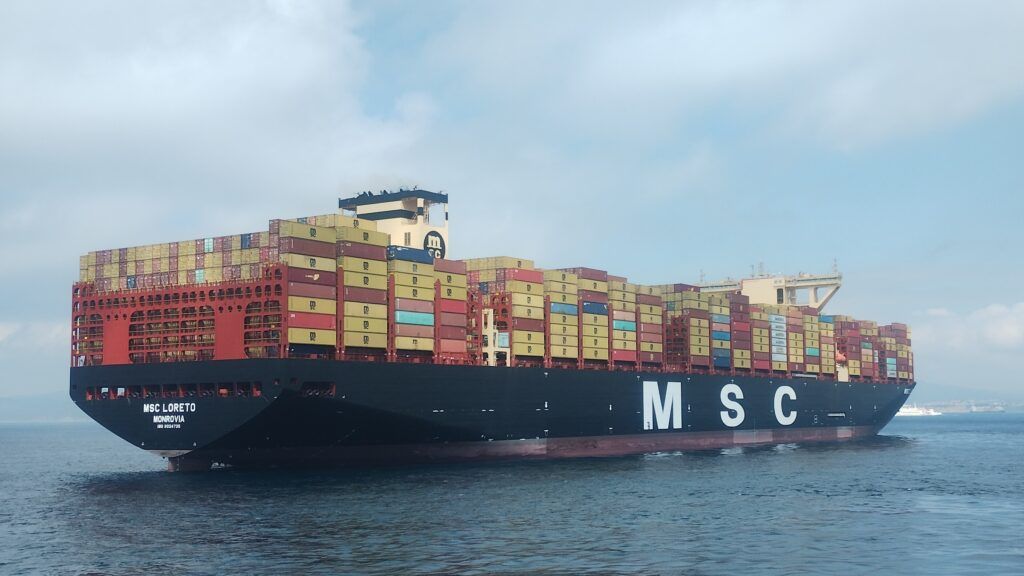
The World’s Largest Container Ships: Do They Have a Future?
At the beginning of the decade, ultra-large container vessels (ULCVs) seemed poised to dominate global maritime trade routes. However, over the past five years, rapid changes driven by multiple factors have cast doubt on the future of this class of ships.

What Are ULCVs?
Ultra-large container vessels are those with a transport capacity exceeding 23,000 TEUs. In the early 2020s, they appeared destined to be the undisputed rulers of the seas and oceans. But with the changes experienced since 2020, a debate has arisen between their supporters and those who question their profitability in future maritime trade scenarios.
- Currently, the largest ULCV is the MSC Irina with 24,346 TEUs, the flagship of this shipping company, navigating the world's seas since 2023. To grasp the dimensions of the world's largest container ship, its 399 meters in length surpass the height of the Empire State Building (381 meters).
Arguments in Favor of ULCVs
Among the arguments of proponents is that ULCVs are excellent tools to meet the growing global demand for products and help reduce costs in the global supply chain. Their economic effectiveness is particularly noticeable on routes covering longer distances, such as those connecting the Asia-Pacific coast with Europe.
Another strong point highlighted by supporters is that these large container ships are among the greatest exponents of technical evolutions that enable the development of environmentally friendly ships. However, sustainability is also an argument used against ULCVs.

Arguments Against ULCVs
Conversely, those who question their future viability point to recent conflict hotspots. For example, instability on certain routes (with the Houthi attacks in the Red Sea as a reference) or uncertainties in U.S. tariff policy have raised doubts about the future growth of maritime trade.
Other challenges for the future of ULCVs should not be overlooked. For instance, these large container ships must also demonstrate that they are as environmentally friendly as possible, considering that various industry players are increasingly concerned with aligning themselves with sustainability.
Another future issue is whether infrastructures can adapt to the most modern ULCVs, whose sizes and transport capacities mean they cannot operate in all ports and major waterways. The average width of these container ships is usually around 60 meters, and the average draft is about 16 meters.
For example, merchant ships with capacities above 20,000 TEUs cannot pass through the Panama Canal—the record on the Central American waterway is held by the MSC Marie with 17,640 TEUs, a milestone achieved on August 30, 2024.

Opportunities and Risks on the Horizon for Container Ships
The future of these ULCVs will be largely determined by their ability to adapt to the changing reality we have been experiencing over the past five years. In recent years, reality has upended some predictions with events such as the COVID-19 pandemic, major international conflicts (Middle East or Ukraine), or trade tensions between major powers.
According to Javier Garrido, Technical Innovation Manager at the Port of Barcelona, this international volatility has had and will have a direct impact on the development of large container ships, as "it makes it difficult to continue with the ULCV growth model."
What kind of merchant ships will we see sailing the seas amid international uncertainty? Garrido envisions a scenario where "current dimensions will be maintained or could increase slightly, but it is most likely that we will move towards a model that allows for flexibility."
After a whirlwind start to 2025 with the tariff war and the military escalation in Yemen, spring has brought some calm. The U.S. and the Houthis agreed to a ceasefire with the commitment to cease attacks on merchant ships in the Red Sea and in critical navigation points such as the Bab al-Mandeb Strait.
Similarly, the tariff truce between China and the U.S. may dispel the clouds looming over international trade with the 90-day truce both parties agreed upon in mid-May 2025.
However, if the "tariff truce" does not come to fruition—or another black swan event affects international trade demand—shipping companies may not see the need to rely on ULCVs to meet their transportation needs.
In any case, and without needing to reach the most pessimistic scenarios, it is important that the development of these ships keeps pace with demand growth to avoid scenarios with excess capacity and very low freight rates.
- During periods of low demand, the operating costs of ULCVs can exceed the revenues generated, leading to financial losses. Shipping companies must carefully balance the size of their fleet with global trade volumes to avoid overcapacity, especially during economic recessions.
Until now, one of the arguments put forth by proponents of large container ships was the advantageous economies of scale they offered. But, according to Garrido, "these are practically exhausted."
- The Technical Innovation Manager at the Port of Barcelona elaborates on this statement by explaining that "for 23,000 TEU containers, we are talking about navigation costs of approximately €5/TEU per day, varying depending on the fuel used. Reducing this cost is already very complex and involves additional costs in infrastructure development on the land side (ports and terminals), making it hardly viable."
Ultra-Large Container Ships Stuck: Infrastructure Doubts
Another problem for ships is that ports also need to update to meet the demands required by the operations involving ULCVs. If the use of large container ships grows, ports with less capacity or those unable to modernize may be relegated to a secondary role.
Javier Garrido expresses this view, considering that "from a technical and purely shipbuilding perspective, larger ships could be designed. However, we would encounter physical barriers in other key elements of the logistics chains. For example, in ports, the draft or the reach of current cranes, or the operational saturation of terminals."
Moreover, ports that do have the capacity to operate with ULCVs risk becoming saturated due to the high volume of traffic from these container ships, potentially becoming bottlenecks that cause congestion on major maritime routes, leading to economic costs for various actors throughout the supply chain.
An analysis of these large merchant ships conducted by Shipfinex, a company specializing in maritime asset management, considers that ports wishing to accommodate these vessels "must have the right combination of deep-water channels, large berths, and enormous cranes capable of loading and unloading containers quickly and safely."
Garrido highlights other risks associated with the accumulation of large ships in key ports, such as "ULCVs exerting a domino effect that causes larger container ships to call at medium and small ports, putting pressure on them to adapt their infrastructures and draft levels."
Will ports be able to face these investments? For the Technical Innovation Manager at the Port of Barcelona, the future scenario in this area is clear, because "it is difficult to maintain the investment pace required by current mega-container ships, except for the world's largest ports. From my point of view, the most affected countries may be those currently developing and, therefore, have port infrastructures with limited capacity."
But ULCVs are not only dependent on favorable geopolitical prospects or infrastructure work to accommodate them. Beyond these issues, there are technical aspects that can determine the future of these ships.

Are Large Container Ships Sustainable?
Garrido emphasizes that one of the current advantages of ULCVs is that, thanks to their large transport capacities, "they can reduce CO₂ emissions per ton of cargo," and also notes that "maritime transport is the most efficient in terms of sustainability."
- ULCVs are equipped with highly advanced engines designed to save fuel. These engines often use dual-fuel technology, allowing them to operate with both traditional heavy fuel oil (HFO) and liquefied natural gas (LNG). The shift towards LNG is particularly significant because it is a much cleaner fuel, emitting fewer pollutants such as sulfur oxides (SOx) and nitrogen oxides (NOx), which are harmful to both the environment and human health.
The future will determine whether ULCVs become the absolute rulers of the seas and oceans or whether uncertainty will sink their promising prospects. If the various stakeholders manage to fully develop their potential, we will undoubtedly witness a factor that contributes to the evolution of international maritime transport towards growth scenarios.





